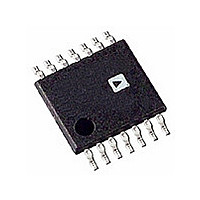AD8343ARU-REEL Analog Devices Inc, AD8343ARU-REEL Datasheet - Page 19

AD8343ARU-REEL
Manufacturer Part Number
AD8343ARU-REEL
Description
IC MIXER ACTIVE HI-IP3 14-TSSOP
Manufacturer
Analog Devices Inc
Series
AD8343r
Datasheet
1.AD8343ARUZ.pdf
(32 pages)
Specifications of AD8343ARU-REEL
Rohs Status
RoHS non-compliant
Rf Type
Cellular, WLAN
Frequency
0Hz ~ 2.5GHz
Number Of Mixers
1
Gain
7dB
Noise Figure
14dB
Secondary Attributes
Up/Down Converter
Current - Supply
60mA
Voltage - Supply
4.5 V ~ 5.5 V
Package / Case
14-TSSOP (0.173", 4.40mm Width)
Operating Temperature (min)
-40C
Operating Temperature (max)
85C
Operating Temperature Classification
Industrial
Lead Free Status / Rohs Status
Not Compliant
Available stocks
Company
Part Number
Manufacturer
Quantity
Price
bandwidth matches. At frequencies above 1 GHz, the real part
of the input impedance rises markedly and it becomes more
attractive to use a 1:1 balun and rely on the L network for the
entire impedance transformation.
In order to obtain the lowest distortion, the inputs of the AD8343
are driven through external ballast resistors. At low frequencies
(up to perhaps 200 MHz), about 5 Ω per side is appropriate;
above about 400 MHz, 10 Ω per side is better. The specified
RF performance values for the AD8343 apply with these ballast
resistors in use. These resistors improve linearity because their
linear ac voltage drop partially swamps the nonlinear voltage
swing occurring on the emitters.
In cases where the use of a lossy balun is unavoidable, it can be
worthwhile to perform simultaneous matching on both the
input and output sides of the balun. The idea is to independently
characterize the balun as a two-port device and then arrange a
simultaneous conjugate match for it. Unfortunately, there seems
to be no good way to determine the benefit this approach offers
in any particular case; it remains necessary to characterize the
balun and then design and simulate appropriate matching n-
etworks to make an optimal decision. One indication that such
effort is worthwhile is the discovery that the adjustment of a
post-balun-only matching network for best gain differs appre-
ciably from that which produces best return loss at the baluns
input. A better tactic is to try a different approach for the balun,
either purchasing a different balun or designing a discrete
network, for lower loss.
For more information on performing the input match, see
the section entitled A Step-by-Step Approach to Impedance
Matching.
INPUT BIASING CONSIDERATIONS
The mixer core bias current of the AD8343 is adjustable from
less than 5 mA to a safe maximum of 20 mA. It is important to
note that the reliability of the AD8343 can be compromised for
core currents set to higher than 20 mA. The AD8343 is tested to
ensure that a value of 68.1 Ω ±1% ensures safe operation.
Higher operating currents reduce distortion and affect gain,
noise figure, and input impedance (Figure 58 and Figure 59).
As the quiescent current is increased by a factor of N, the real
part of the input impedance decreases by N. Assuming that a
match is maintained, the signal current increases by √N, but the
signal voltage decreases by √N, exercising a smaller portion of
the nonlinear V–I characteristic of the common base connected
mixer core transistors and results in lower distortion.
At low frequencies where the magnitude of the complex input
impedance is much smaller than the bias resistor values, ade-
quate biasing can be achieved simply by connecting a resistor
from each input to GND. The input terminals are internally
biased at 1.2 V dc (nominal), so each resistor has a resistance
Rev. B | Page 19 of 32
value calculated as R
well matched in order to maintain full LO to output isolation;
1% tolerance resistors are recommended.
At higher frequencies where the input impedance of the AD8343
rises, it is beneficial to insert an inductor in series between each
bias resistor and the corresponding input pin in order to mini-
mize signal shunting (Figure 72). Practical considerations limit
the inductive reactance to a few hundred ohms. The best overall
choice of inductor is the value that places the self-resonant
frequency at about the upper end of the desired input frequency
range. Note that there is an RF stability concern that argues in
favor of erring on the side of too small an inductor value; see
the Input and Output Stability Considerations section. The
Murata LQW1608A series of inductors (0603 SMT package)
offers values up to 56 nH before the self-resonant frequency
falls below 2.4 GHz.
For optimal LO-to-output isolation, it is important not to
connect the dc nodes of the emitter bias inductors together
in an attempt to share a single bias resistor. Doing so causes
isolation degradation arising from V
transistors in the core.
Figure 59. Effect of R3 and R4 Value on Input IP3 and Gain Compression
25
20
15
10
20
16
12
Figure 58. Effect of R3 and R4 Value on Gain and Noise Figure
5
0
8
4
0
20
20
40
TOTAL SUPPLY CURRENT
40
TOTAL SUPPLY CURRENT
60
60
BIAS
80
80
= 1.2/I
INPUT IP3
R3 AND R4 (Ω)
R3 AND R4 (Ω)
P1dB
GAIN
100
100
BIAS
INPUT RF = 900MHz
OUTPUT IF = 170MHz
LO LOW SIDE INJECTION
INPUT RF = 900MHz
OUTPUT IF = 170MHz
LO LOW SIDE INJECTION
120
. The resistor values should be
120
BE
140
mismatches of the
140
NOISE FIGURE
160
160
180
180
AD8343
200
200
90
80
70
60
50
40
30
20
10
0
100
90
80
70
60
50
40
30
20
10
0
















